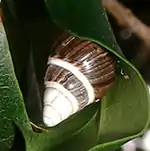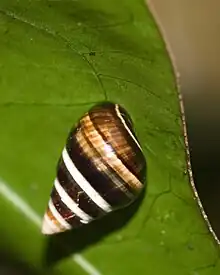Achatinella mustelina
Achatinella mustelina is a species of air-breathing land snail, a terrestrial pulmonate gastropod mollusc in the family Achatinellidae. This species is endemic to the Waianae Range of the island of Oahu, Hawaii.

| Achatinella mustelina | |
|---|---|
 | |
| Scientific classification | |
| Domain: | Eukaryota |
| Kingdom: | Animalia |
| Phylum: | Mollusca |
| Class: | Gastropoda |
| Subclass: | Heterobranchia |
| Order: | Stylommatophora |
| Family: | Achatinellidae |
| Genus: | Achatinella |
| Subgenus: | Achatinella |
| Species: | A. mustelina |
| Binomial name | |
| Achatinella mustelina Mighels, 1845 | |
All 13 subspecies of Achatinella mustelina were synonymized with the species by Holland & Hadfield (2007),[3] because they are not monophyletic.[3]
Habitat
Elevated forests that are dry, wet, or mesic. A. Mustelina attaches itself to leaves at the tops of native trees and shrubs such as Metrosideros polymorpha, Dubautia plantanginea, Myrsine lessertiana, Pisonia sandwicensis, Antidesma platyphyllum and Nestegis sandwicensis. Some individual may live on a single tree for their entire lifetime.
Range Elevation: 600 to 1158 m[4]
Physical Description
A. Mustelina from different locations vary in size, shape, and color. Adults range from 19–24 mm in length, with an average length of 214 mm. The shells have a shiny finish and are usually brown with light bands that circle the suture convex, or they are white with transverse black or brown lines.[5]
Development
A. mustelina develops from an intrauterine embryo, and its growth in utero is thought to be logarithmic. A. mustelina is that individuals of different sizes grow at the same time.[6]
Reproduction
A. mustelina is hermaphroditic and may self-fertilize. Has a lengthy gestation period and gives birth to large, live young that mature late and have a low fecundity. A. mustelina breeds year-round.[7]
Lifespan
A. mustelina has long lifespan compared to other terrestrial gastropods. Longetivity is estimated to be 10 years, but individuals may live up to 15 to 20 years.[8]
Food
A. mustelina feeds primarily at night. Both adults and larvae graze on fungus on surface of leaves at night.[7]
References
- Hadfield, M.; Hadway, L. (1996). "Achatinella mustelina". IUCN Red List of Threatened Species. 1996: e.T191A13048229. doi:10.2305/IUCN.UK.1996.RLTS.T191A13048229.en. Retrieved 15 November 2021.
- "Appendices | CITES". cites.org. Retrieved 14 January 2022.
- Holland B. S. & Hadfield M. G. (2007). "Molecular Systematics of the Endangered O‘ahu Tree Snail Achatinella mustelina: Synonymization of Subspecies and Estimation of Gene Flow between Chiral Morphs". Pacific Science 61(1): 53-66. doi:10.1353/psc.2007.0007
- Bicescu, Peter; Stalter, Colleen. "Achatinella mustelina". Animal Diversity Web. Retrieved 17 April 2023.
- https://www.researchgate.net/figure/Endangered-Oahu-tree-snail-Achatinella-mustelina-shells-at-different-stages-of_fig2_262143172
- "NatureServe Explorer 2.0". explorer.natureserve.org. Retrieved 17 April 2023.
- "Endangered Snails of Makua Valley Are Placed at Risk by Army Fires -". Retrieved 17 April 2023.
- https://pcsuhawaii.org/projects/oanrp/reports/2017/05.pdf
